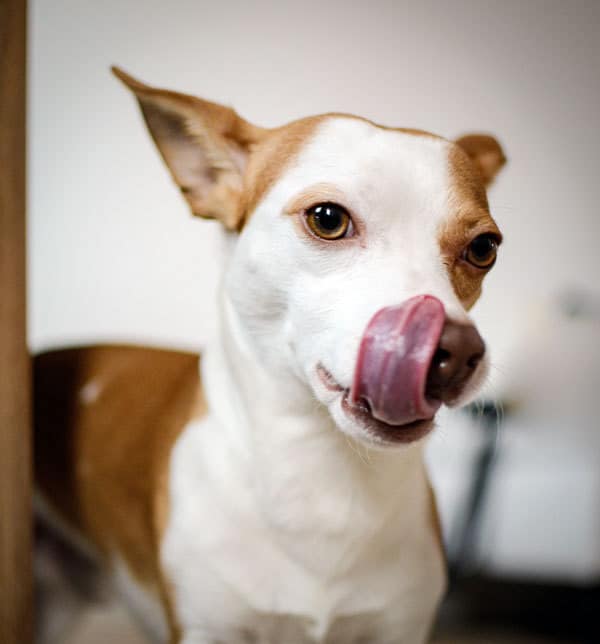Stress relief acupressure points to help both you and your dog. If you are feeling stressed, your dog is too. Dogs pick up their emotional cues from their humans. We think we are hiding our feelings, but our animals have an uncanny sensitivity to us. When you are angry, doesn’t your dog react by becoming amazingly passive? That’s because he thinks he is calming you down by his being very calm. When you’re happy and full of energy, your dog is bouncy and eager to enjoy your happiness. Well, when you are experiencing stress, your dog is feeling every bit of it as well.
Signs of Stress in Dogs
We are aware when our stress barometer is escalating. Dogs are even more “creative” about how they signal their stress. It’s up to us to be conscious of what their signals are so we can help reduce their stress. There are mild canine indicators of stress and if not addressed immediately, the dog’s physical and emotional stress can increase to scary heights.
Physical Stress Signals
Mild physical stress signals can include increased yawning, shaking, licking lips, panting, scratching and drooling. As the dog’s stress level increases, shed excessively, open his eyes unusually wide, cower, tremble, pace, tuck his tail between his legs or just wag the tip of his tail, pin his ears back or overly erect his ears, experience urinary incontinence, and gastrointestinal issues (e.g., diarrhea or constipation).

Photo by Isabel Vittrup-Pallier
Physical signs that a dog is extremely stressed and can become dangerous to himself and others are: tense body stance, raised hackles, puffed-out tail, lips stretched upward, teeth showing, menacing stare at dogs or humans before attacking, plus excessive licking or chewing on his own limbs.
Behavioral Stress Signals
Behavioral changes of any type can indicate a dog is experiencing stress. Milder signals tend to be increased sleeping, clinginess, or periodic withdrawing. As the dog’s feelings of stress continue to increase, he may hide, become agitated, evince decreased appetite, engage in destructive behaviors, and increase vocalization such as growling, barking, whining, or whimpering.

Photo by Tracey Hocking
As a dog’s stress escalates, his level of simple agitation can turn to outright aggression or an extreme fear response such as running away or completely shutting down emotionally. Though dogs are considered predatory by nature, when highly stressed their “fight or flight” response comes into play. Different breeds react differently. For instance, Greyhounds may appear comatose when overwhelmingly stressed while the Akita Inu is more apt to become highly aggressive.
Given how stress is at best uncomfortable and at its extreme a life-threatening situation for us and our animals, how can we help ourselves and our beloved animals when dealing with stressful times?
Natural Stress Relief
Behaviorists give us lots of really good suggestions about how to contain canine stress. Recommendations often include establishing a routine, reducing stimulation, increasing exercise, working on focused training, creating a safe “cave-like” place, decreasing noise volume, instituting tasks, or having more playtime.
Turid Rugaas, a well-respected canine behaviorist, suggests that we use what she calls “calming signals.” These signals are ones that dogs use themselves to calm other dogs and you, for that matter. Calming signals include licking the lips, yawning, looking away, arcing and not walking directly at the dog when approaching, becoming completely passive, and rolling over. You may not want to roll over, but using the other calming signals is doable. You will be responding to your dog in a language he understands.
Because your dog is taking most of his emotional cues from you, there’s something you can do to help remedy your own stress level while reducing your dog’s stress.
Stress Relief Acupressure Points for You
Bringing down stress during the holidays begins with you. If you are feeling emotionally balanced, your dogs will be a lot happier and so will you. Acupressure is a simple and easy way to lower stress.
To begin your stress relief session, find a comfortable, safe, intimate location for you and your dog. Relax by taking three deep breaths and exhaling slowly. Often a dog matches your breathing pattern and settles. While sitting with your dog, place your thumb lightly on the medial (under) side of your arm above your wrist and, simultaneously, place your middle finger gently on the opposite (lateral or top) side of your wrist as shown in the photograph below. Breathe  naturally while holding these two acupressure points for a slow count to 20. Repeat this procedure on your opposite arm.
naturally while holding these two acupressure points for a slow count to 20. Repeat this procedure on your opposite arm.
Pericardium 6 (Pe 6), Inner Gate
Located in the middle of the medial side of your forearm in the soft tissue between your tendons just beyond your wrist toward your elbow.
Triple Heater 5 (TH 5), Outer Gate
Located directly opposite Pe 6 on the lateral side of your forearm in the soft spot between the radius and ulna bones.
Now that you are feeling calmer, you are ready to offer your dog a brief acupressure session.
Stress Relief Acupressure Points for Your Dog
Shift your awareness to helping your dog cope with the inherent stress factors the holiday season brings. Think about how much you want to share this acupressure session with him. Begin by using the exact same acupressure points you just applied on yourself. See the photographs below. Gently hold the two acupoints on his forelimb at the same time and then repeat this procedure on his opposite forelimb when slowly counting to 20.
There are two more acupressure points, also called “acupoints,” that you can add to your dog’s session to enhance his relaxation and bring down his stress level. The other two acupoints are the An Shen points located behind his ears and the Bai Hui point located in the center of his sacrum where there’s a little flat spot. These are classical canine acupoints known specifically to reduce stress and anxiety. Dogs like to scratch, so you are welcome to gently scratch these acupoints while counting to 20 slowly.

Remember, the spirit of the holidays is to give and receive love and caring. Sharing acupressure is a perfect way to express and experience the spirit of the holidays. Carving out your special time every day or two to share an acupressure session with your dog will make your holiday season even more joyous for you both.
Learn how to use acupressure to treat a variety of conditions in Amy and Nancy’s articles here on Animal Wellness Guide, in their hands-on and online courses, and in their books on canine, feline and equine acupressure:




